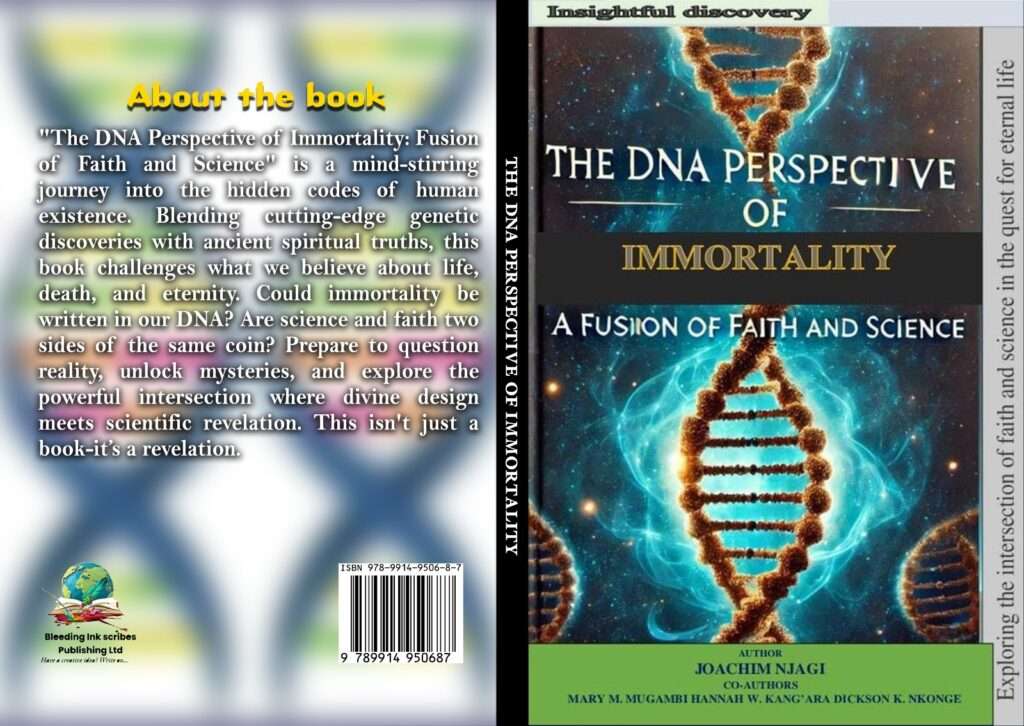Authors: Joachim Njagi, Mary M. Mugambi, Hannah W. Kang’ara, and Dickson K. Nkonge
Publisher: Bleeding Ink Scribes Publishing Ltd (2025)
ISBN: 978-9914-9506-8-7
Review by: Bonface Otieno Okinyi
Introduction
The DNA Perspective of Immortality presents a bold intellectual undertaking that traverses the twin towers of empirical science and theological reflection. The authors attempt to bridge centuries of tension between religious orthodoxy and genetic empiricism by addressing a timeless human yearning: the quest for eternal life. The text provides a sweeping interrogation of genetic science, the Christian theological tradition, and existential philosophy, weaving these strands into a narrative that speculates on whether DNA—deoxyribonucleic acid—may be the vessel of eternal life, both metaphorically and potentially literally.

Major Problems Addressed
The core problem interrogated in the book is human mortality—its inevitability, its meaning, and whether it is, in fact, biologically necessary. The authors tackle several interrelated intellectual challenges:
- Can eternal life be achieved biologically through the longevity of DNA?
- Does the structure and resilience of DNA mirror theological doctrines of the soul and resurrection?
- Is the supposed opposition between faith and science intellectually sustainable?
- How might future technological advancements (AI, cloning, and genetic reprogramming) interact with spiritual beliefs about life, death, and identity?
By addressing these questions, the book opens a broader ethical debate about what it means to be human in an age of rapidly evolving biotechnology.
The central tension in the book lies in the ontological and epistemological conflict between scientific reductionism and spiritual transcendentalism. Is the human being reducible to molecular code? Or is there an immaterial essence—the soul—that transcends genetics?
While genetics suggests a material continuity through DNA (the “immortality” of genes), Christian theology insists on a spiritual immortality—the persistence of the soul beyond physical death. The book seeks not to resolve this dichotomy but to harmonise it, arguing for a complementary relationship: DNA may be the physical carrier of divine intention and thus a vessel for immortality. This book explores other important issues like:
a) Theological Anthropology
The book probes theological questions of identity, creation, and resurrection. It aligns human DNA with scriptural references like the “Book of Life” and the “Word made flesh,” suggesting that DNA may be the physical manifestation of divine authorship.
b) Posthumanism and Ethical Frontiers
Discussions on cloning, synthetic biology, and digital consciousness open up posthuman concerns. If we can digitally reconstruct or clone individuals, what ethical lines are crossed?
c) Spiritual Metaphysics
The authors explore whether DNA might act as a metaphysical antenna—receiving divine signals—and whether spiritual disciplines (like prayer or meditation) can impact gene expression, referencing epigenetics.
d) Scripture and Immortality
Passages from John 3:16, 1 Corinthians 15, and Psalms are drawn upon to support theological claims that life is divinely encoded and that resurrection may involve a kind of “genetic glorification” (i.e., perfected DNA).
Though this is a nonfiction/philosophical work, the “characters” are ideological positions and metaphors:
- DNA emerges as a “protagonist”—a molecular structure with the power to connect past and future, biology and spirituality.
- Science is personified as the sceptical but curious partner.
- Faith is cast as the ancient, steadfast companion that continues to offer hope and meaning beyond empirical knowledge
While people continue to ask pertinent questions on issues life, death and life after beyond death, this book is culturally relevant in the current society in the following ways
- In an age where AI and genetics threaten to redefine personhood, the book asks essential ethical and metaphysical questions.
- It offers a framework for religious people to engage with science, not defensively, but dialogically.
- It challenges the materialist view of identity, suggesting that human beings are more than biological machines.
- As climate change, pandemics, and transhumanist aspirations shape public discourse, this book insists that the human soul and biological continuity must be understood together.
Literary and Rhetorical Styles
a) Socratic Inquiry
The book uses a questioning tone throughout, avoiding dogmatism. It invites readers into a conversation, not a sermon or a scientific lecture.
b) Metaphorical Language
Frequent metaphors liken DNA to a “book”, a “code”, a “vessel”, or a “divine signature”, creating theological resonance.
c) Juxtaposition and Parallelism
Chapters alternate between scientific exposition (e.g., cellular senescence, telomeres, aging) and theological reflection (e.g., resurrection, divine image, glorified bodies).
d) Intertextuality
Biblical texts are placed side by side with molecular biology findings (e.g., John 1:1 beside genetic transcription), producing a powerful dialogic effect.
e) Academic Referencing
The book includes multiple scientific citations and footnotes, showing intellectual rigour and grounding its speculative theology in real research.
Conclusion
The DNA Perspective of Immortality is a provocative, deeply engaging work that dares to bridge the sacred and the scientific. It reframes eternal life not as an abstract theological promise, but as a question encoded in our very being. Whether one agrees with all its conclusions or not, the book compels us to rethink mortality, personhood, and destiny in the age of gene editing and theological decline.
This is a book for theologians, geneticists, philosophers, and anyone grappling with what it means to be human. It is not the final word—but it is a powerful and needed invitation to the conversation.
Reference
Njagi, J., Mugambi, M. M., Kang’ara, H. W., & Nkonge, D. K. (2025). The DNA Perspective of Immortality: A Fusion of Faith and Science. Bleeding Ink Scribes Publishing Ltd

